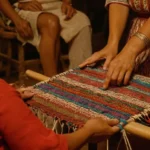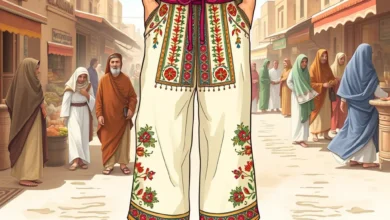The shayla is a significant piece of clothing, often seen in Arab cultures. More than just a fabric covering the hair, it embodies a rich tapestry of identity, tradition, and evolving personal expression. This article delves into the nuances of the shayla, exploring its history, cultural significance, and contemporary interpretations.
Understanding the Shayla: More Than Just a Headscarf
At its most basic, the shayla is a long, rectangular scarf. It’s usually made from light, flowing material and is worn draped over the head and shoulders, often leaving the face visible. While commonly grouped with other headscarves, the shayla possesses its distinct characteristics and carries its own unique cultural weight. It’s important to differentiate it from other types of veiling like the hijab, niqab, or burqa, which vary considerably in their coverage and associated cultural contexts.

The Difference Between Shayla and Other Headscarves
Let’s clarify some common terms:
- Shayla: Typically a light scarf draped over the head and shoulders, allowing the face to be seen.
- Hijab: A more common term, generally refers to any head covering that covers the hair, neck, and chest. The face is visible.
- Niqab: Covers the face, leaving only the eyes visible, and may or may not be worn with a headscarf.
- Burqa: The most concealing garment, covering the entire body, including the face, with a mesh panel over the eyes.
It’s important not to conflate these terms. The shayla is more about modesty and cultural expression than full concealment.
See also Assam Silk: The History of India’s ‘Liquid Gold’ in Global Luxury
Assam Silk: The History of India’s ‘Liquid Gold’ in Global LuxuryHistorical Roots of the Shayla
The practice of veiling, in various forms, has deep roots in the Middle East and predates Islam. It’s believed to have originated from a combination of factors, including climate considerations (protection from sun and sand), social status markers, and evolving religious interpretations. The exact origins of the shayla itself are difficult to pinpoint, but it’s clear that similar forms of head coverings have existed for centuries within the region.
Evolution of the Shayla Through Time
Over time, the shayla has evolved from its basic form into a diverse range of styles, fabrics, and embellishments. Factors that influence this evolution include:
- Regional Variations: Different regions within the Arab world have developed unique styles and preferences.
- Social Trends: As fashion changes, so do the styles and designs of the shayla.
- Religious Interpretations: While not mandated in the Quran, the practice of veiling has different interpretations within Islamic thought.
- Personal Preferences: Women express their individuality through their choice of color, fabric, and style.
The Shayla and Modesty
One of the key functions of the shayla is to promote modesty. In many Arab cultures, modesty is a valued concept, and the shayla is a visible expression of this value. It is understood as a way to protect a woman’s privacy and to present oneself in a respectful manner. The way it is worn often varies depending on personal preference and the context of the situation, but the overarching goal is to present oneself modestly.
Modesty as a Cultural Concept
Modesty isn’t just about clothing; it’s about behavior and presentation. The shayla is a physical manifestation of a broader cultural expectation. This isn’t about forced suppression, but rather a complex interplay of religious, social, and personal choices.
See also Backstrap Loom Weaving: Mexico’s Ancient Craft Thriving in the Modern Era
Backstrap Loom Weaving: Mexico’s Ancient Craft Thriving in the Modern EraThe Shayla as a Symbol of Identity
Beyond modesty, the shayla is a powerful symbol of identity. It connects women to their heritage, their communities, and their beliefs. For many Arab women, it is a proud expression of their cultural background and a visual reminder of their belonging. It’s a piece of clothing that embodies tradition while also being adaptable to modern lifestyles.

Community and Belonging
Wearing a shayla can create a sense of solidarity among women. It signifies shared values and cultural norms, fostering a feeling of community. This is evident at gatherings, religious events, and everyday interactions, where the shayla becomes a visible marker of cultural identity.
The Shayla and Personal Expression
Despite its role in cultural and religious contexts, the shayla is far from a uniform piece of clothing. Women use it as a canvas for personal expression. The choice of fabric, color, and style allows for individuality and creativity. From simple, everyday styles to elaborate, embellished designs for special occasions, the shayla can communicate personal taste and fashion sense.
Fashion and Individuality
The evolution of shayla design shows a beautiful fusion of traditional styles and contemporary trends. Fashion designers are embracing this, creating pieces that cater to both modern tastes and cultural expectations. This demonstrates that personal style can coexist with cultural norms.
The Shayla in the Modern World
In the modern world, the shayla continues to evolve, balancing tradition with contemporary styles. Women are wearing it in diverse contexts, from professional settings to social events. Its adaptability and enduring significance make it a relevant garment for many Arab women today.
Balancing Tradition and Modernity

The shayla’s continued relevance is a testament to its adaptability. It isn’t seen as an outdated garment but as a meaningful expression of faith, culture, and personal style that fits into a modern lifestyle.
The Shayla and Misconceptions
It’s crucial to address misconceptions surrounding the shayla. The garment is often conflated with other forms of veiling, leading to assumptions about oppression and lack of freedom. This misunderstanding overlooks the individual choices and cultural contexts that inform women’s decisions about wearing it.
Challenging Stereotypes
Many women choose to wear the shayla as an expression of their faith and personal identity. It should not be seen as a sign of oppression, but rather a deeply personal choice, often linked to cultural and religious beliefs. This complex topic requires an understanding beyond stereotypical assumptions.
Choosing a Shayla: Practical Considerations
If you’re interested in wearing or learning more about the shayla, consider the following:
- Fabric: Light, breathable fabrics like cotton, chiffon, and georgette are common. The material affects the drape and feel of the shayla.
- Size: Shaylas come in various sizes. The length and width are often based on personal preference and style of wearing it.
- Color: Colors range from neutral tones for daily wear to vibrant hues for special occasions.
- Design: Styles vary, from simple and unadorned to elaborate designs with embellishments.
- Context: Consider the event or setting when choosing a shayla. A simple design is appropriate for daily use, while more intricate ones are suitable for formal events.
The Significance of the Shayla: A Summary
In conclusion, the shayla is much more than just a piece of fabric. It represents a complex interplay of identity, tradition, and personal expression. This garment reflects cultural values while allowing women to embrace modernity, showing the beautiful adaptability of tradition in a rapidly changing world.
It serves as a symbol of modesty, community, and personal style. It’s a crucial part of Arab culture and should be understood with respect and awareness. By learning about the shayla, we gain a deeper appreciation for the rich diversity of cultural expression.
Key Takeaways
Here are some key ideas about the Shayla to remember:
- The shayla is a rectangular scarf draped over the head and shoulders.
- It is distinct from other forms of veiling like the hijab, niqab, and burqa.
- It has deep historical roots in the Middle East.
- It’s a powerful symbol of identity and tradition.
- It’s used as a means of personal expression and style.
- It’s a versatile garment that can be adapted to modern lifestyles.
- It should not be confused with other forms of veiling or associated with oppression.
By gaining a better understanding of the shayla, we can foster a greater respect for diverse cultural traditions and challenge misinterpretations that often surround them. The shayla is an enduring symbol of cultural richness and personal expression that continues to evolve in the modern world.




